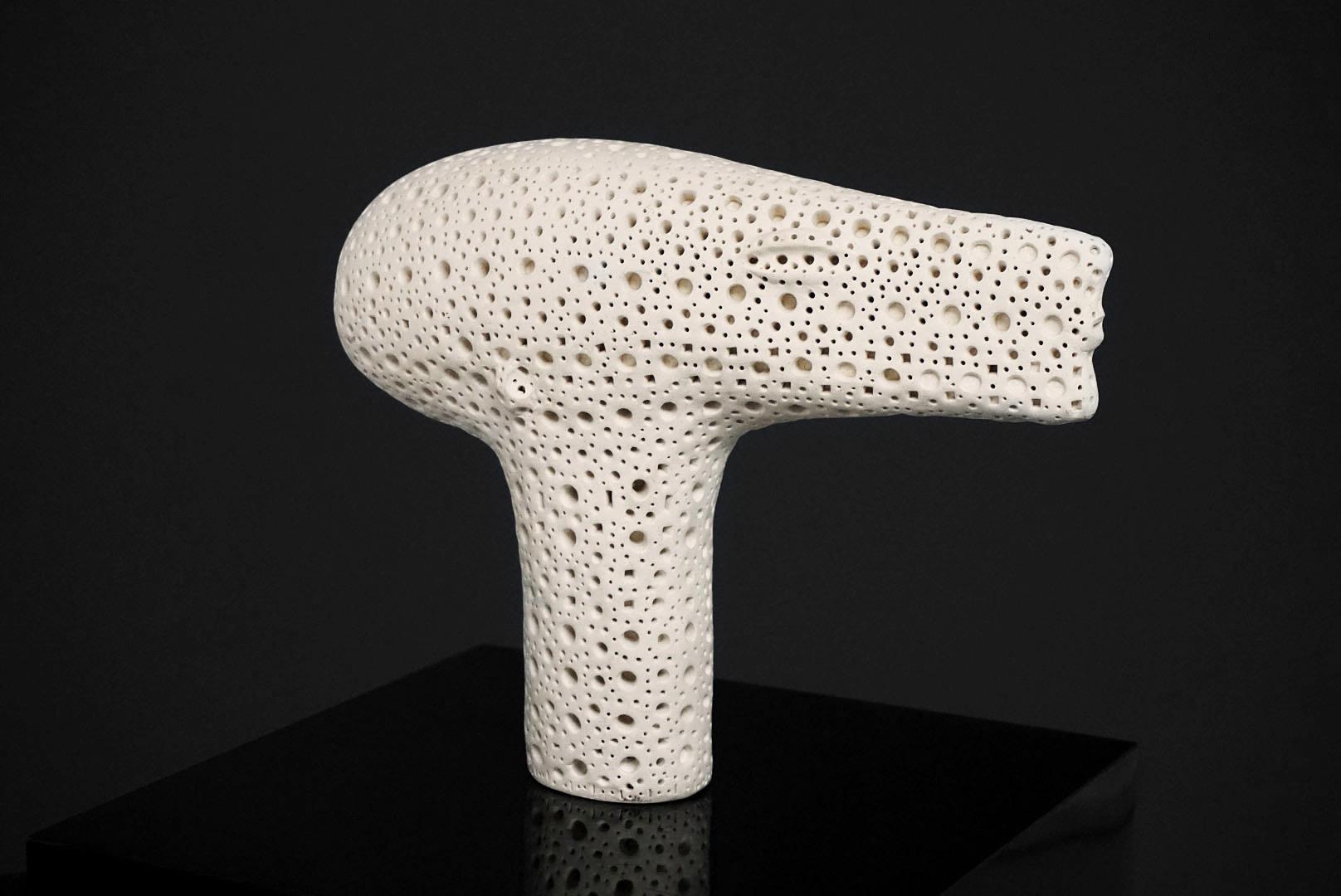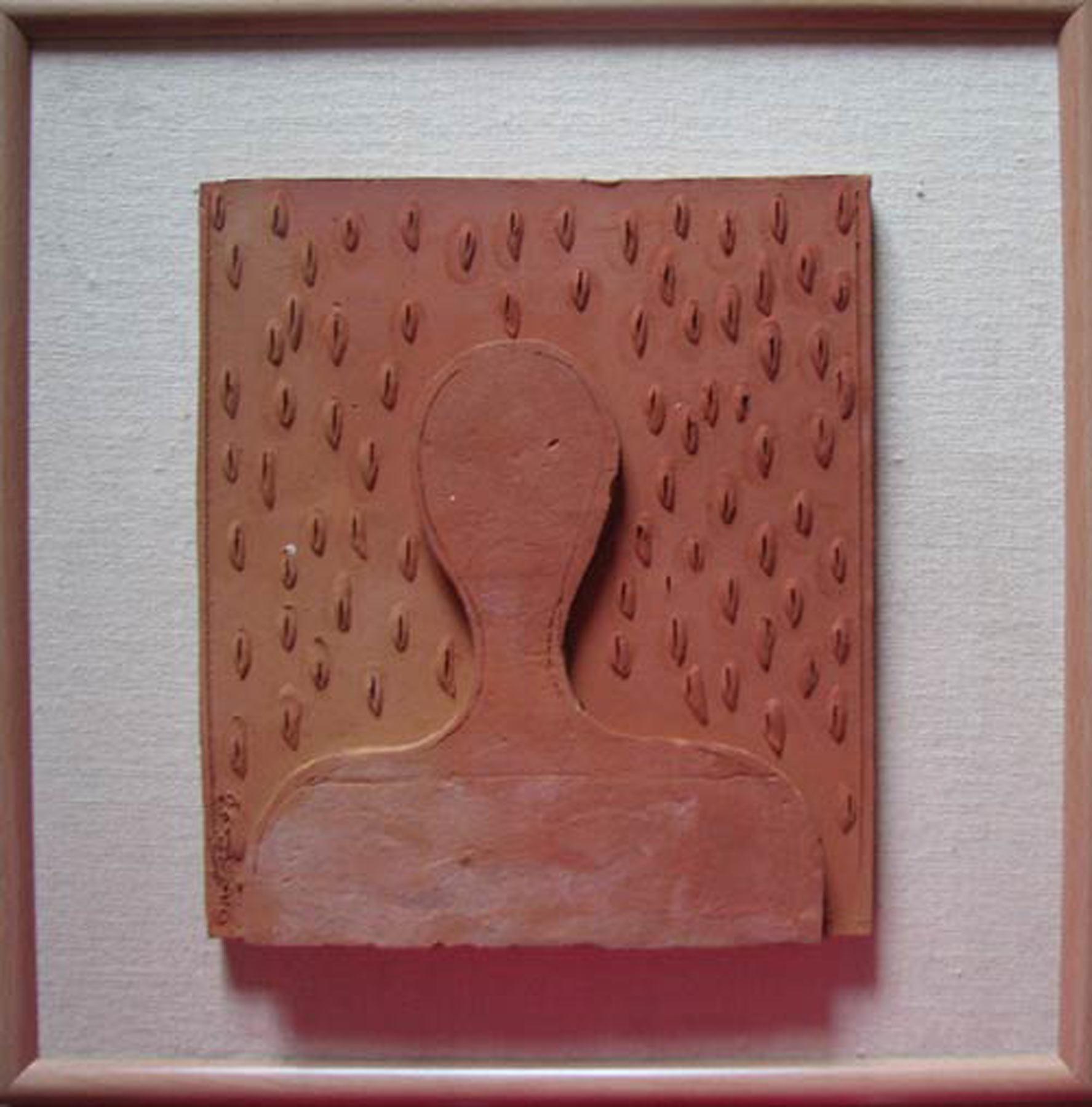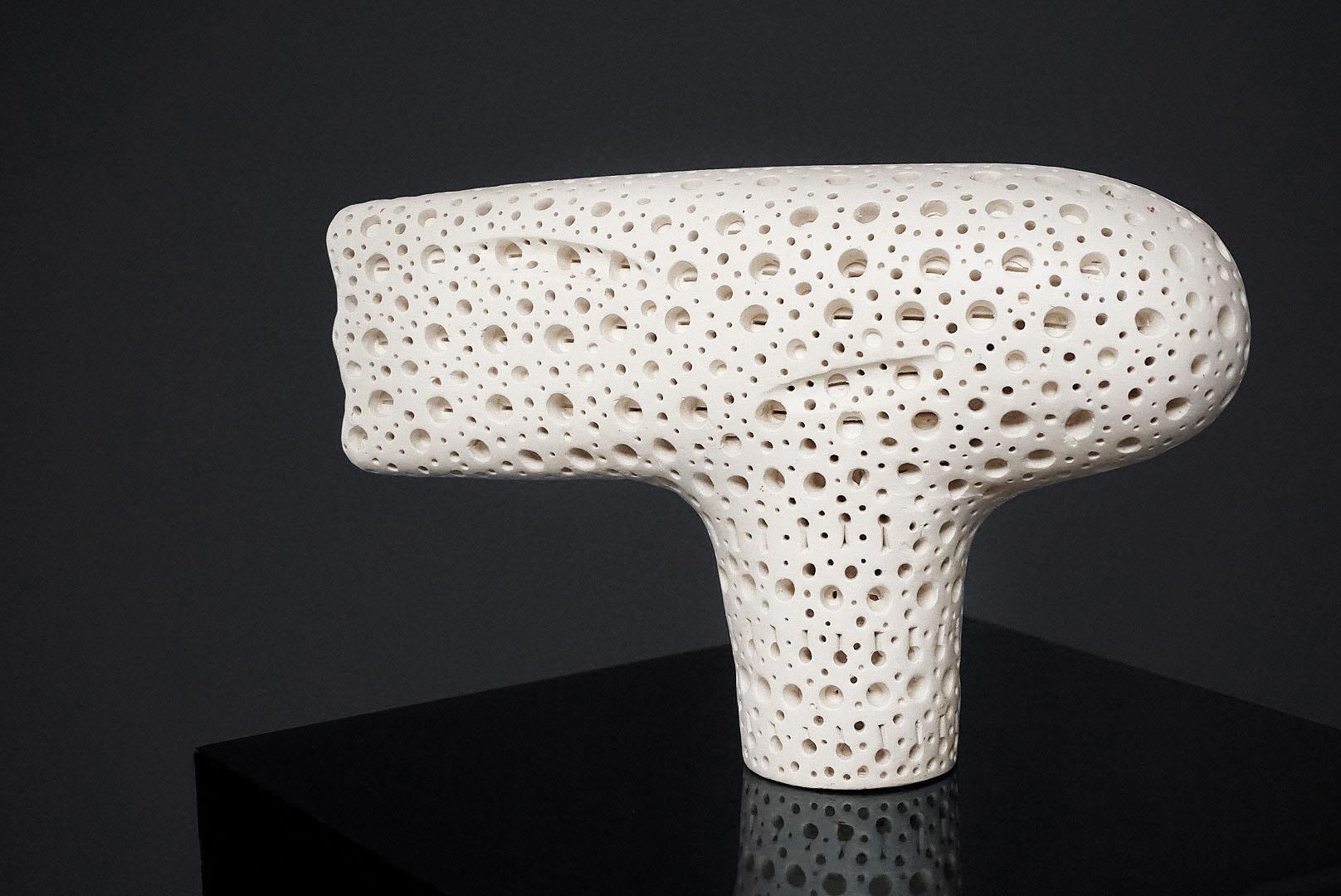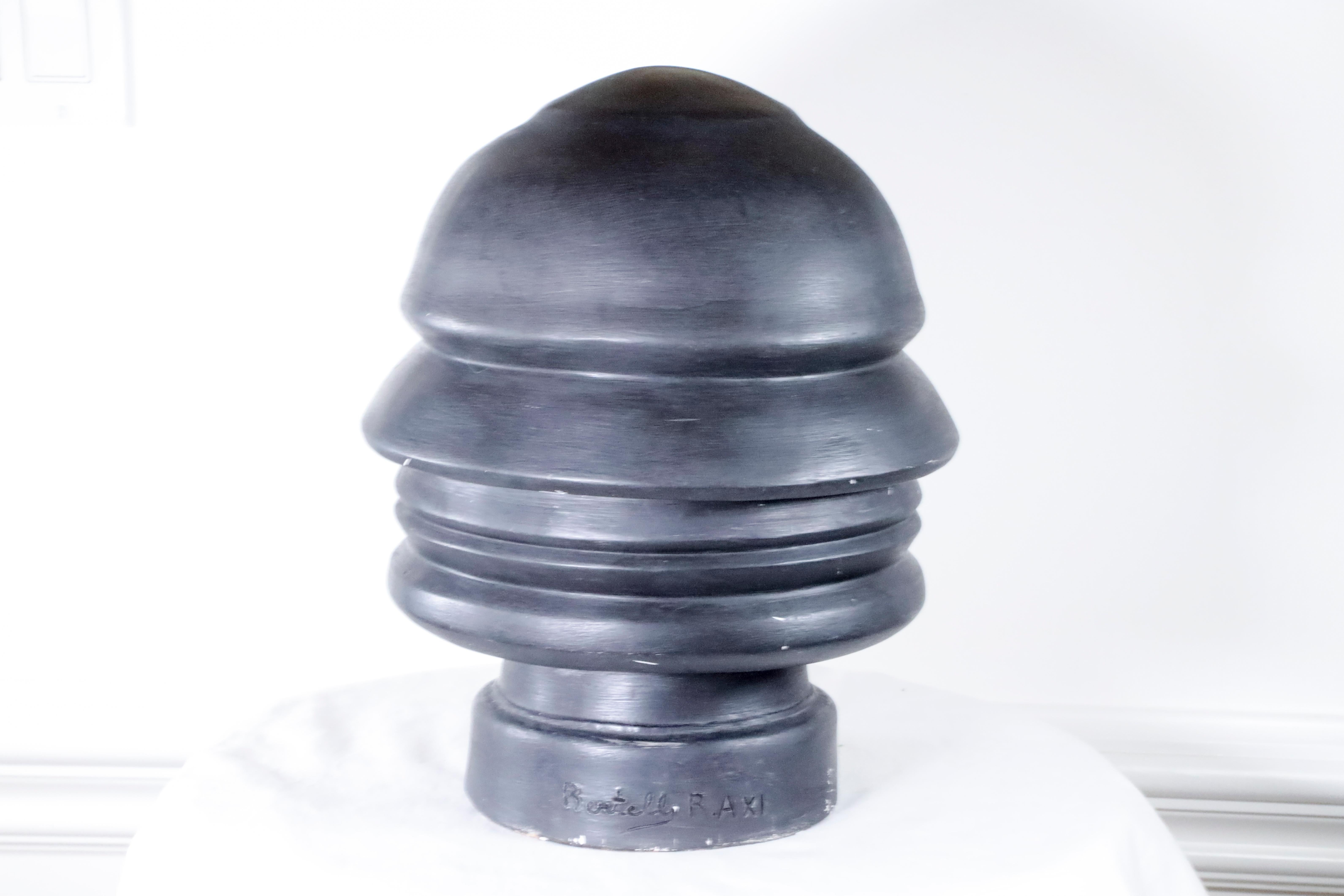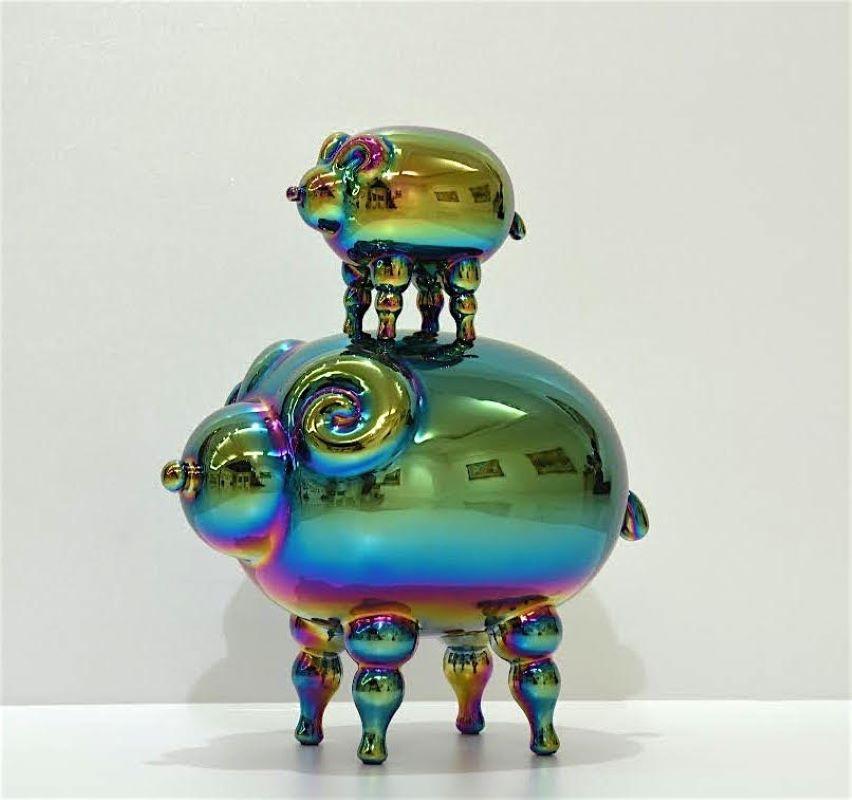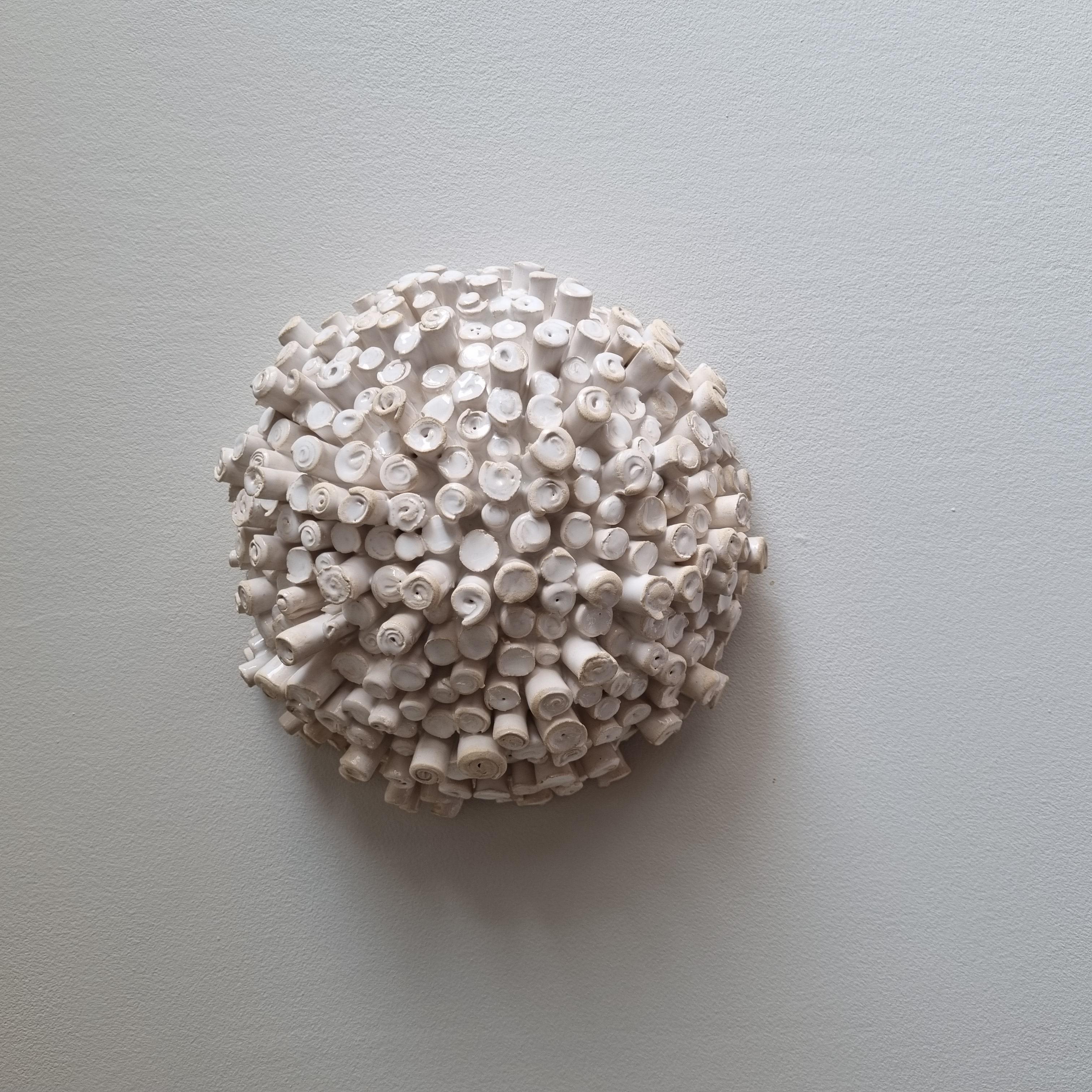Items Similar to Homage à Kahnweiler
Want more images or videos?
Request additional images or videos from the seller
1 of 6
Irmgard BiernathHomage à Kahnweiler1984
1984
About the Item
Irmgard Biernath (1905 Waldheim in Saxony - 1998 Mainz), Hommage à Kahnweiler, 1984. Terracotta relief, burnished red body, 43.5 x 38 cm, mounted on support plate, in wooden frame 57 x 49.5 cm, monogrammed "IB" at lower right.
- Isolated patina losses, but overall good condition, frame slightly bumped.
- The Appearance of Genius-
This homage to Daniel-Henry Kahnweiler shows the gallerist and art theorist as Pablo Picasso portrayed him in his lithographic portrait of 1957.
As an innovative Parisian gallery owner, Kahnweiler had exclusively represented Picasso since 1911, while Picasso had painted his famous portrait of Kahnweiler the previous year as a major work of Cubism. And it is Picasso who appears at the centre of Irmgard Biernath's image. Here, his face echoes the features of the self-portrait he painted in 1907 in the Prague National Gallery.
His eyes are wide open as he gazes into the distance, surrounded by the works of his artistic vision that have already taken shape. On the right is the bronze "Man with Sheep" from 1943, and on the left a flower representing Picasso's painterly work.
Kahnweiler, who was closely associated with Picasso's work, looks at the sculptures on the table in front of him with great attention and admiration. His head joins the sculptures and the flower to form a circle that surrounds Picasso's face like a wreath of honor, so the homage to Kahnweiler is first and foremost a homage to Picasso. As a sculptor inspired by Picasso's work, Irmgard Biernath herself follows in the footsteps of the artistic genius, whose face she makes appear on her relief as on the sweat shroud of Veronica.
About the artist
Irmgard Biernath worked as a teacher in Berlin from 1929. Because of her denunciation in 1941, she voluntarily resigned from teaching. After the Second World War, she followed her true calling as an artist and studied from 1946 at the Berlin-Weißensee School of Art with Bernhard Heiliger and from 1948 at the Nuremberg Academy of Fine Arts, where she was a master student of Hans Wimmer, among others. To earn a living, she taught art at the Anne Frank Realschule in Mainz from 1953 to 1971, for which she created a bust of Anne Frank. From 1958 to 1964 she was also a lecturer at the University Institute for Art and Work Education in Mainz. In addition, she was active at the Volkshochschule (adult education center), where she established the field of art education with her concept "Forming Hands" and left her mark for decades. From the 1960s on, Irmgard Biernath devoted herself more and more to her own work, working exclusively as a freelance artist since 1971.
Irmgard Biernath's artistic estate is housed in the museum of her hometown of Waldheim, where the Irmgard Biernath Foundation is also located.
Irmgard Biernath received numerous awards. Among others, she received the Federal Cross of Merit in 1976, the Rembrandt Medal in 1990, and the Mainz Plate, also in 1990.
Exhibitions
Kennen Sie ...? Biernath! Werke aus dem Nachlass der Bildhauerin Irmgard Biernath, Kulturzentrum Waldheim 2011.
Harmonie und Gleichgewicht im Werk der Irmgard Biernath, Stadt- und Museumshaus Waldheim, 2022.
Selected Bibliography
Irmgard Biernath (Hrsg.): Irmgard Biernath, Mainz 1990.
Marlene Hübel: Irmgard Biernath. Ein Lebenswerk, Mainz 1995.
Saur. Allgemeines Künstlerlexikon, Band 10, München - Leipzig 1995, S. 576-577.
GERMAN VERSION
Irmgard Biernath (1905 Waldheim in Sachsen - 1998 Mainz), Hommage à Kahnweiler, 1984. Terracotta-Relief, brünierter roter Scherben, 43,5 x 38 cm, auf Trägerplatte montiert, im Holzrahmen 57 x 49,5 cm, rechts unten mit „IB“ monogrammiert.
- Sehr vereinzelte Verluste der Patina, insgesamt aber wohlerhalten, Rahmen etwas bestoßen.
- Die Erscheinung des Genius -
Die Hommage an Daniel-Henry Kahnweiler zeigt den Galeristen und Kunsttheoretiker in der Art wie ihn Pablo Picasso in seinem lithographischen Porträt von 1957 dargestellt hat.
Als innovativer Pariser Galerist hatte Kahnweiler Picasso ab 1911 exklusiv vertreten, während Picasso im Jahr zuvor sein berühmtes Porträt Kahnweilers als ein Hauptwerk des Kubismus malte. Und Picasso ist es, der im Zentrum des Bildes von Irmgard Biernath erscheint. Dabei folgt sein Antlitz den Zügen des 1907 geschaffenen Selbstporträts der Prager Nationalgalerie.
Mit weit geöffneten Augen schaut er in die Ferne, während er bereits von den gestaltgewordenen Werken seiner künstlerischen Vision umgeben ist. Rechts neben ihm steht die Bronze „Mann mit Schaf“ aus dem Jahre 1943 und links ist eine Blume zu sehen, die für Picassos malerischen Werk einsteht.
Voller Aufmerksamkeit betrachtet der mit dem Werk Picassos eng verbundenen Kahnweiler die vor ihm auf dem Tisch situierten Skulpturen, zu denen er bewundernd aufblickt. Dabei verbindet sich sein Kopf mit den Skulpturen und der Blume zu einer Picassos Antlitz wie ein Ehrenkranz umgebenden Kreisform, weshalb die Hommage an Kahnweiler vor allem eine Hommage an Picasso ist. Als eine von Picassos Oeuvre inspirierte Bildhauerin tritt Irmgard Biernath selbst in die Fußstapfen des Künstlergenies, dessen Antlitz sie auf ihrem Relief wie auf dem Schweißtuch der Veronika zur Erscheinung bringt.
zur Künstlerin
Irmgard Biernath war ab 1929 Lehrerin in Berlin. Aufgrund ihrer Denunziation 1941 schied sie freiwillig aus dem Schuldienst aus. Nach dem Zweiten Weltkrieg folgte sie ihrer eigentlichen Berufung als Künstlerin und studierte ab 1946 an der Kunsthochschule Berlin-Weißensee bei Bernhard Heiliger und ab 1948 an der Akademie der Bildenden Künste Nürnberg, wo sie unter anderem Meisterschülerin bei Hans Wimmer war. Um den Brotererb zu sichern, war sie von 1953 bis 1971 Kunstlehrerin an der Mainzer Anne Frank Realschule, für die sie eine Büste der Anne Frank schuf. Von 1958 bis 1964 war sie auch Dozentin am Hochschulinstitut für Kunst- und Werkerziehung Mainz. Zudem war sie an der Volkshochschule tätig, wo sie den Bereich Kunsterziehung mit ihrem Konzept der „Formende Hände“ aufbaute und über Jahrzehnte hinweg prägte. Ab den 1960er Jahre widmetet sich Irmgard Biernath zusehend ihrem eigenen Schaffen, um dann ab 1971 ausschließlich als freischaffende Künstlerin tätig zu sein.
Der künstlerische Nachlass befindet sich im Museum ihrer Geburtsstadt Waldheim, wo auch die Irmgard-Biernath-Stiftung ansässig ist.
Irmgard Biernath wurden zahlreiche Ehrungen zuteil. So erhielt sie unter anderem 1976 das Bundesverdienstkreuz, 1990 die Rembrandt-Plakette und ebenfalls 1990 den Mainzer Teller.
Ausstellungen
Kennen Sie ...? Biernath! Werke aus dem Nachlass der Bildhauerin Irmgard Biernath, Kulturzentrum Waldheim 2011.
Harmonie und Gleichgewicht im Werk der Irmgard Biernath, Stadt- und Museumshaus Waldheim, 2022.
Auswahlbibliographie
Irmgard Biernath (Hrsg.): Irmgard Biernath, Mainz 1990.
Marlene Hübel: Irmgard Biernath. Ein Lebenswerk, Mainz 1995.
Saur. Allgemeines Künstlerlexikon, Band 10, München - Leipzig 1995, S. 576-577.
- Creator:Irmgard Biernath (1905 - 1998, German)
- Creation Year:1984
- Dimensions:Height: 17.33 in (44 cm)Width: 14.97 in (38 cm)Depth: 1.97 in (5 cm)
- Medium:
- Movement & Style:
- Period:
- Condition:
- Gallery Location:Berlin, DE
- Reference Number:1stDibs: LU2438213127682

About the Seller
5.0
Vetted Seller
These experienced sellers undergo a comprehensive evaluation by our team of in-house experts.
Established in 2014
1stDibs seller since 2023
7 sales on 1stDibs
Typical response time: 5 hours
- ShippingRetrieving quote...Ships From: Berlin, Germany
- Return PolicyA return for this item may be initiated within 14 days of delivery.
More From This SellerView All
- Madonna del Dito - Heavenly beauty down to the fingertip -Located in Berlin, DEKPM, Madonna del Dito, oval, slightly curved porcelain picture plate by KPM Berlin in fine polychrome onglaze painting, 27 x 22 cm (plate size), 33 x 28.5 cm (frame), unsigned, press...Category
1880s Academic More Art
MaterialsPorcelain, Oil
- Rudolf v. Rittner as Florian Geyer - Last man standing -By Lovis CorinthLocated in Berlin, DELovis Corinth (1858 Tapiau - 1925 Zandvoort), Rudolf von Rittner as Florian Geyer, 1924 (Müller 854), drypoint signed in pencil. 20.4 × 14.2 (plate size), 37.7 × 30.6 cm (sheet size). Published by Karl Nierendorf, Berlin. Framed in a passepartout. - Strong, precise impression. Frame a little bit rubbed and with two small damages. About the artwork The knight is a leitmotif in Lovis Corinth's work, culminating in his Self-Portrait in Armour of 1914. Of all the paintings on this theme, Corinth most often depicted Florian Geyer. Descended from a Franconian noble family, he fought for the freedom of the peasants during the peasant wars of the Reformation, first diplomatically and then militarily, leading the legendary Schwarzen Haufen (Black Troops). The name derives from the black uniforms with which Geyer dressed the peasants willing to fight. During the Napoleonic occupation, the freedom fighter Florian Geyer was sung about by the Romantics, and the free corps Die Schwarze Schaar, founded in 1813 by Major von Lützow, succeeded the Schwarzer Haufen. It was against this historical background that Gerhard Hauptmann wrote the revolutionary drama Florian Geyer, which premiered at the Deutsches Theater in Berlin in 1896. While the actor Rudolf Rittner, who would later appear in Fritz Lang's films, initially played the role of Schäferhans, he took over the leading role in the new production at Berlin's Lessing Theatre in 1904, again directed by Emil Lessing, which established his fame as an actor. Hauptmann himself praised the acting. He wrote to Hugo von Hofmannsthal: "It went quite well with Florian Geyer. In any case, I had the great pleasure of seeing the play again in an admirable performance". And Lovis Corinth was so taken with Rittner's performance that he painted an oil portrait of him in the role of Florian Geyer in 1906. After two further graphic versions in 1915 and 1920/21, Corinth returned to the painting a year before his death and almost twenty years after the oil painting to create this graphic version in 1924. Even the inscription in the picture was taken over. This proves all the more the importance of the knight and freedom fighter for Corinth's self-image. The oil painting, in particular, proclaims the single-minded determination to fight to the last for the values defended, manifested in the oil painting by the tattered flag held out to the enemy. There is a parallel with Rainer Maria Rilke's 1899 story The Cornet, in which the protagonist goes down with the flag that he first saved at the risk of his life. Consequently, the portrait is also a self-portrait, and the knight's armour is not an academic costume or an ironic refraction, but an expression of Corinth's self-image, which also includes his self-representation as an artist. The Secession poster...Category
1920s Expressionist Figurative Prints
MaterialsEtching
- Evening - The depth of the visible -Located in Berlin, DEMax Clarenbach (1880 Neuss - Cologne 1952), Evening. Etching, 18 x 41 cm (platemark), 33.5 x 57 cm (frame), inscribed "Abend" in pencil at lower left, signed and dated "M. Clarenbach. 28.III.[19]09". Framed and mounted under glass. - Somewhat browned and slightly foxed. About the artwork The horizontally elongated etching depicts the panoramic view of a small town as seen from the other side of the river. There are gabled houses on the left and a mighty church spire on the right. The bourgeois houses and the large religious building indicate the urban character. These buildings are rendered in dark tones to emphasise the lighter row of houses in the centre of the picture, closer to the water. The chiaroscuro contrast creates two parallel planes that open up a space for the imagination of what the city could be. The imagination is stimulated by the almost entirely dark, barely recognisable buildings, while the arm of the river leading into the city further stimulates the imagination. However, as the silhouette of the city as a whole is reflected in the water, the parallel planes are perceived as a band of houses that stretches across the entire horizontality of the etching and seems to continue beyond the borders of the picture. The reflection has almost the same intensity as the houses themselves, so that the band of buildings merges with their reflection to form the dominant formal unit of the picture. Only the parallel horizontal hatching creates the convincing impression of seeing water, demonstrating Max Clarenbach's mastery of the etching needle. The water is completely motionless, the reflection unclouded by the slightest movement of the waves, creating a symmetry within the formal unity of the cityscape and its reflection that goes beyond the motif of a mere cityscape. A pictorial order is established that integrates everything in the picture and has a metaphysical character as a structure of order that transcends the individual things. This pictorial order is not only relevant in the pictorial world, but the picture itself reveals the order of the reality it depicts. Revealing the metaphysical order of reality in the structures of its visibility is what drives Clarenbach as an artist and motivates him to return to the same circle of motifs. The symmetry described is at the same time inherent an asymmetry that is a reflection on art: While the real cityscape is cut off at the top of the picture, two chimneys and above all the church tower are not visible, the reflection illustrates reality in its entirety. The reflection occupies a much larger space in the picture than reality itself. Since antiquity, art has been understood primarily as a reflection of reality, but here Clarenbach makes it clear that art is not a mere appearance, which can at best be a reflection of reality, but that art has the potential to reveal reality itself. The revealed structure of order is by no means purely formalistic; it appears at the same time as the mood of the landscape. The picture is filled with an almost sacred silence. Nothing in the picture evokes a sound, and there is complete stillness. There are no people in Clarenbach's landscape paintings to bring action into the picture. Not even we ourselves are assigned a viewing position in the picture, so that we do not become thematic subjects of action. Clarenbach also refrains from depicting technical achievements. The absence of man and technology creates an atmosphere of timelessness. Even if the specific date proves that Clarenbach is depicting something that happened before his eyes, without the date we would not be able to say which decade, or even which century, we are in. The motionless stillness, then, does not result in time being frozen in the picture, but rather in a timeless eternity that is nevertheless, as the title "Abend" (evening), added by Clarenbach himself, makes clear, a phenomenon of transition. The landscape of the stalls is about to be completely plunged into darkness, the buildings behind it only faintly discernible. The slightly darkened state of the sheet is in keeping with this transitional quality, which also lends the scene a sepia quality that underlines its timelessness. And yet the depiction is tied to a very specific time. Clarenbach dates the picture to the evening of 28 March 1909, which does not refer to the making of the etching, but to the capture of the landscape's essence in the landscape itself. If the real landscape is thus in a state of transition, and therefore something ephemeral, art reveals its true nature in that reality, subject to the flow of phenomena, is transferred to an eternal moment, subject to a supra-temporal structure of order - revealed by art. Despite this supratemporality, the picture also shows the harbingers of night as the coming darkening of the world, which gives the picture a deeply melancholy quality, enhanced by the browning of the leaf. It is the philosophical content and the lyrical-melancholic effect of the graphic that give it its enchanting power. Once we are immersed in the image, it literally takes a jerk to disengage from it. This etching, so characteristic of Max Clarenbach's art, is - not least because of its dimensions - a major work in his graphic oeuvre. About the artist Born into poverty and orphaned at an early age, the artistically gifted young Max Clarenbach was discovered by Andreas Achenbach and admitted to the Düsseldorf Art Academy at the age of 13. "Completely penniless, I worked for an uncle in a cardboard factory in the evenings to pay for my studies.” - Max Clarenbach At the academy he studied under Arthur Kampf, among others, and in 1897 was accepted into Eugen Dücker...Category
Early 1900s Realist Landscape Prints
MaterialsEtching
- In the forest of Durlach - Quiet ripple in a secret place -Located in Berlin, DEFranz Xaver Graessel (1861 Oberasbach/Baden - 1948 Emmering). In the forest of Durlach. 1881. Pencil drawing, heightened with white, on grey-green paper. 33 x 41.7 cm. Signed, dated and inscribed by the artist himself: 'Franz Graessel. Durlach, 12 April 1881". About the artwork The drawing depicts a view of the woods which, as if sharpening the visual focus, remains diffuse at the edges and does not allow the viewer to locate himself in the picture. As a result, the landscape appears to be an apparition, but at the same time it is given real substance by the solidity of the massive arched bridge made of quarry stone. As the main motif of the painting, the bridge, which blends in with nature like an archaic relic, also acts as a visual guide, drawing attention to the white, raised waters of the stream and the surrounding vegetation. The diffusion of perception that takes place there, however, draws the eye back to the bridge and thus to the overall view. This movement initiating a constant alternation of diffusion and concretion, which is the specific tension of the painting that brings the landscape to life. The materialisation and dematerialisation, however, does not take place solely through the eye's wandering through the picture; it is simultaneously linked to the viewer's approach to and distance from the picture, which loses its richness of detail precisely in the close-up, only to reconfigure itself with increasing distance. In this work, which dates from Graessel's studies in Karlsruhe, the artist reflects on the emergence of pictorial objectivity. Here, however, nature is more than a mere motif. The real connection between culture and nature is symbolically expressed by the choice of green paper. The drawing is an impressive testimony to Graessel's mastery of the sprezzatura with which he skilfully applies the most abstract of strokes, which visibly merge towards the centre of the picture. The signature and the exact date prove that Graessel gave this work more than the character of a mere sketch. About the artist Franz Graessel grew up in an environment that was to nourish his later key motifs: his parents' house was a mill. After attending the Karlsruhe Academy of Art from 1878 to 1884, where he studied under Carl Hoff, Graessel continued his training at the Munich Academy from 1886 to 1890 as a pupil of Wilhelm von Lindenschmidt. Trained primarily in genre and portrait painting, he initially portrayed the life of Black Forest farmers. From 1894 he turned increasingly to animal painting, concentrating on the depiction of ducks and geese, which earned him the nickname 'Enten-Graessel'. Graessel's work thus parallels that of Alexander Koester...Category
1880s Naturalistic Landscape Drawings and Watercolors
MaterialsPaper, Chalk, Pencil
- Clay jug on a bench - The essence of the clay jar revealed by the sunlight -By Hans Richard von VolkmannLocated in Berlin, DEHans Richard von Volkmann (1860 Halle (Saale) - 1927 ibid.), Clay jug on a bench. Pencil and Watercolour on paper. 20 x 26,7 cm (visible size), 37 x 45 cm (frame), dated and monogrammed lower left "Februar 1890 - HR. V. V." - Minimally tanned. Framed behind glass in a passepartout. About the artwork Using the technique of his early youth - pencil and watercolour - Hans Richard von Volkmann depicts a still life. However, this is not a conventional indoor still life, but an open-air depiction, painted outdoors and not in the studio. It is therefore an open-air painting, characteristic of von Volkmann's oeuvre, which could have been painted in the Willingshausen colony of painters, where open-air painting was programmatically practised there and the artist stayed there that year. And indeed, this painting is a manifesto of open-air painting. Von Volkmann demonstrates that leaving the studio for the light of nature leads to an entirely new quality of art. To prove this, he uses the genre of still life, which can be described as the studio subject par excellence. Moreover, light plays an essential role in the classical still life. It is the real protagonist of the still life. And it is precisely this moment, essential to the still life, that von Volkmann exploits to demonstrate the potential of plein-air painting: He presents the objects as they appear in the sunlight. The date of February and the bare branches in the foreground make it clear that this is a clear winter day in bright sunlight. The delicate plant in the foreground casts a clearly defined shadow, as does the jug. However, the shadow is most pronounced on the jug itself: The underside of the handle appears almost black, making the top, and therefore the jug itself, shine all the more brightly. The shining of the objects in the sunlight is also visible on the bench. As complementary phenomena to the shadow zones, light edges can be seen on the boards of the seats and the upper foot of the bench shines entirely in the light. To achieve this intensity of light, von Volkmann activated the bright white of the painting ground. By depicting the objects in glistening sunlight, von Volkmann demonstrates that this quality of light is only to be found outdoors. And this light leads to a new way of looking at the objects themselves. The jug on the bench seems like an accidental arrangement, as if the artist had stumbled upon this unintentional still life and captured it with fascination. And in this fascination there is a moment of realisation that refers to the objects themselves. It is only when they shine brightly in the sunlight that their true nature is revealed. In this way, sunlight allows the objects to come into their own, so to speak. Sunlight, which is not present in the studio, gives the still life an entirely new dimension of reality, which is also reflected in the colours interwoven by the sunlight: The bench and the jug stand in a harmonious grey-pink contrast to the green of the implied meadow. The emphasis on the jug as the central subject of the picture also implies that the watercolour has not been completed. This non finito inscribes a processuality into the picture, making it clear that something processual has been depicted, the temporality of which has been made artistically permanent. This is why von Volkmann signed the painting and dated it to the month. About the Artist Von Volkmann made his first artistic attempts at the age of 14. He painted many watercolours of his home town of Halle. This laid the foundation for his later outdoor painting. In 1880 his autodidactic beginnings were professionalised with his admission to the Düsseldorf Art Academy. There he studied under Hugo Crola, Heinrich Lauenstein, Johann Peter Theodor Janssen and Eduard von Gebhardt until 1888. Von Volkmann then moved to the Karlsruhe Academy, where he was Gustav Schönleber's master pupil until 1892. In 1883 he came for the first time to Willingshausen, Germany's oldest painters' colony, at the suggestion of his student friend Adolf Lins...Category
1890s Naturalistic Still-life Drawings and Watercolors
MaterialsWatercolor
- Autumn Landscape in Sunlight - Indian Summer -Located in Berlin, DEFrederick Vezin (1859 Torresdale Philadelphia - 1933 Düsseldorf), Autumn Landscape in the Sunlight, oil on canvas, mounted on cardboard, 32 x 41 cm (inside measurement), 44 x 51 cm (...Category
Early 1900s Impressionist Landscape Paintings
MaterialsOil, Cardboard
You May Also Like
- Alexander Ney, 'Teacher' Unique Sculpture, 2008By Alexander NeyLocated in New York, NYThe unique minimalist ‘Teacher’ sculpture by visionary artist Alexander Ney is handcrafted using italian white terra cotta, created in 2008. Ney is a contemporary visual artist, work...Category
Early 2000s Contemporary Figurative Sculptures
MaterialsTerracotta
- Terracotta, Plate , Brick, Brown, Black colors by Indian Artist "In Stock"By Gautam DasLocated in Kolkata, West BengalGautam Das - Untitled - 8.5 x 8.5 inches Gautam Das is a master Terracotta and mural Artist. He studied in the Kala Bhavana and currently presides as th...Category
Early 2000s Contemporary Figurative Sculptures
MaterialsTerracotta
- Alexander Ney, 'Guardian' Unique Sculpture, 2012By Alexander NeyLocated in New York, NYThe ‘Guardian’ by visionary artist Alexander Ney was handcrafted using italian white terra cotta in 2008. Ney began his professional career as a highly productive visual artist, as a...Category
2010s Minimalist Figurative Sculptures
MaterialsTerracotta
- Continuous Profile of Mussolini "Profilo ContinuoLocated in Brookville, NYRenato Giuseppi Bertellis Born in 1900 in Lastra a sign and died in Florence in 1974. The title is sometimes given as Head of Mussolini, but is better known as Head of Mussolini (Co...Category
Mid-20th Century Futurist Figurative Sculptures
MaterialsTerracotta
- SheepLocated in New York, NYHung Yi was born in Taichung, Taiwan in 1970. The artist’s works are inspired by Taiwanese culture or day-to-day life in Taiwan. In the 1990s, it was popula...Category
2010s Contemporary Abstract Sculptures
MaterialsEnamel, Steel, Stainless Steel
- Abstraction Male - Unique Handmade Modern Glazed Ceramics Wall SculptureBy Monika Zadurska-BielakLocated in Salzburg, ATWeigt of the sculpture 2,15 kg Monika Zadurska-Bielak, Graduated from the studio of Prof. Franciszek Duszeńko at the Faculty of Sculpture of the Acade...Category
2010s Contemporary Abstract Sculptures
MaterialsCeramic
